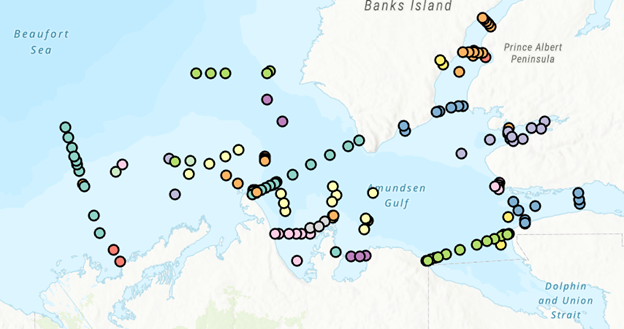Mussels
Type of resources
Topics
Keywords
Contact for the resource
Provided by
Formats
Representation types
Update frequencies
status
-

A derivative of DFO’s benthic species survey for the Strategic Program for Ecosystem-based Research and Advice (SPERA) (open data record ID: e736c0f0-b19e-4842-903d-28bfc756d48a), this benthic survey funded through the Canadian Healthy Oceans Network (CHONeII) looks at the presence/absence and abundance of two biogenic habitat-forming species that are listed as vulnerable to disturbance in a subset of 50 drift camera transects in the ‘Head Harbour/West Isles Archipelago/The Passages’ Ecologically and Biologically Significant Area (EBSA) in the Bay of Fundy, New Brunswick, Canada (~113km2). Presence/absence and abundance data of the stalked sea squirt (Boltenia ovifera) and horse mussel (Modiolus modiolus) were derived from the use of high-resolution Nikon D800 36.1 megapixel still images (n=2576, see link to parent record for more descriptive survey information) to be used in species distribution modelling. Image field of view (FOV) was estimated using a 10 cm-wide trigger weight for scale,and standardized across images using the average FOV estimate (0.75 x 0.5 m) across a subset of 200 images. Species counts were then converted to abundance estimates (number of individuals per square-meter) by dividing counts by 0.375m2. Boltenia ovifera was observed at densities reaching 456 ind./m2, while Modiolus modiolus density reached a maximum of 240 ind./m2. Cite this data as: Mireault C.A., Lawton P., Devillers R. and Teed L. Presence/absence and abundance of vulnerable marine ecosystem species Boltenia ovifera and Modiolus modiolus in the lower Bay of Fundy derived from high resolution still imagery. Published September 2023. Coastal Ecosystems Science Division, Fisheries and Oceans Canada, St. Andrews, N.B. https://open.canada.ca/data/en/dataset/152ae3f1-d2b9-43d9-a7b4-d769d9e9fc41
-

From August 6th to September 9th, 2014, Fisheries and Oceans Canada conducted a baseline survey of marine fishes and their habitats on the Canadian Beaufort Shelf and slope. Sampling was conducted from the F/V Frosti at 56 stations along thirteen transects, with an additional three stations not located on transects. Standardized sampling was conducted on the transects at pre-determined depth stations (20-40, 75, 200, 350, 500, 750, and 1000 m) using a variety of sampling equipment including benthic fishing trawls, plankton nets, sediment cores, and CTD and water sample profiles. Presented here is the information on the sampling locations, and the sampling gear deployed at each station.
-

PURPOSE: The Department of Fisheries and Oceans (DFO) conducted a baseline survey of biological communities and habitat parameters in the offshore Canadian Beaufort Sea between 2012 and 2014, as part of the federally administered Beaufort Regional Environmental Assessment. The BREA-Marine Fishes Project (BREA-MFP) was the first comprehensive baseline study of offshore marine fish diversity and associated habitats in the Canadian Beaufort Sea. Knowledge gained during the BREA-MFP supports regulatory processes pertaining to offshore development and Oceans Management in the Inuvialuit Settlement Region, and provides baseline context for studies of the effects of climate change and variability. The Canadian Beaufort Sea – Marine Ecosystem Assessment (CBS-MEA, 2017-2019 and 2021-2024) is building on system baselines and ecological knowledge derived from the BREA-MFP to develop a comprehensive research and monitoring approach for the offshore Canadian Beaufort Sea. This approach will enable us to better understand the relationship between oceanographic drivers and ecosystem responses. The CBS-MEA focuses on integrating oceanography, food web linkages, physical-biological couplings and spatial and inter-annual variabilities, while also expanding baseline coverage of species diversity, abundances, and habitat associations to areas of the Beaufort Sea and Canadian Archipelago that are previously unstudied in this context. DESCRIPTION: Between 2017 and 2019, and between 2021 and 2024, Fisheries and Oceans Canada conducted a baseline survey of marine fishes and their habitats on the Canadian Beaufort Shelf and slope in August and early September each year. Sampling was conducted from the F/V Frosti at over 150 stations along ten multi-year transects, and over 50 non-transect stations. Standardized sampling was conducted at pre-determined depth stations (20-40, 75, 200, 350, 500, 750, and 1000 m) using a variety of sampling equipment including benthic fishing trawls, plankton nets, sediment cores, and CTD and water sample profiles. Presented here is the information on the sampling locations, and the sampling gear deployed at each station.
 Arctic SDI catalogue
Arctic SDI catalogue